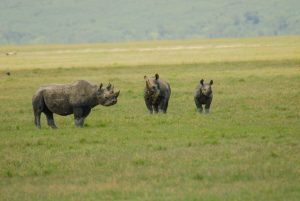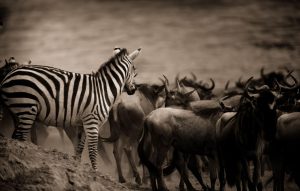Quick Facts
About Arusha National Park
Peak Time
June - October
Best Time To Go
Year-Round
Famous For
Mount Meru and beautiful Momella Lakes
Home Of
Diverse birdlife and unique landscapes
Overview
Arusha National Park is a small but incredibly diverse gem located just outside the city of Arusha in northern Tanzania. Covering an area of approximately 552 square kilometers, this park is famous for being home to Mount Meru, Tanzania’s second-highest peak, and the stunning Momella Lakes, which are known for their striking shades of blue and green. The park’s varied landscapes, from lush forests to open savannahs and alkaline lakes, offer a range of habitats that support a wide variety of wildlife. It’s the perfect destination for visitors looking for scenic beauty, wildlife encounters, and outdoor adventures in a compact area.

Wildlife
Although Arusha National Park doesn’t host the large herds found in other Tanzanian parks, it offers a unique opportunity to see a wide variety of species in a relatively small area. The park is home to giraffes, zebras, buffaloes, and bushbucks, as well as blue monkeys, black-and-white colobus monkeys, and baboons in the forested areas. The open grasslands and swamps provide excellent opportunities to see warthogs, elephants, and even the occasional leopard. Flamingos can often be seen feeding at the Momella Lakes, while Cape buffalo are commonly found grazing in the lower plains.
Mount Meru
Standing at 4,566 meters, Mount Meru is one of the park’s key attractions. This dormant stratovolcano offers challenging treks for hikers, with scenic trails passing through lush forests and past wildlife. The summit provides breathtaking views of the Kilimanjaro to the east and the entire Arusha National Park below. Hiking Mount Meru is an excellent adventure for trekking enthusiasts and those looking to acclimatize before attempting to climb Kilimanjaro.
Momella Lakes
The Momella Lakes are a series of shallow, alkaline lakes located in the northeastern part of the park. Each lake has a different color, ranging from blue to green, due to varying levels of mineral deposits. These lakes are a haven for bird watchers, as they attract an abundance of birdlife, including flamingos, herons, and pelicans. The tranquil waters and scenic surroundings offer perfect opportunities for a relaxing boat safari or nature walk along the lakeshores.
Scenic Landscapes
Arusha National Park boasts an extraordinary variety of landscapes, from the lush, forested slopes of Mount Meru to the open savannahs and swampy plains of the park’s lower areas. The Ngurdoto Crater, often referred to as a mini-Ngorongoro, is a lush volcanic caldera with steep walls and a marshy floor, offering stunning panoramic views and a great spot for wildlife viewing. The contrast between the towering volcanic peaks and the serene lakes makes Arusha National Park one of the most picturesque destinations in Tanzania.
Activities
Arusha National Park offers a variety of activities to help visitors fully experience its natural beauty:
- Game Drives: Explore the park’s diverse landscapes and spot wildlife, from zebras in the savannah to monkeys in the forest.
- Canoeing on Momella Lakes: Paddle through the serene waters of the lakes, getting up close to flamingos, hippos, and other birdlife.
- Mount Meru Trekking: Challenge yourself with a hike up Mount Meru and enjoy spectacular views of Mount Kilimanjaro and the surrounding landscapes.
- Walking Safaris: Accompanied by a ranger, discover the park’s rich flora and fauna on foot, with opportunities to observe wildlife at a closer range.
- Bird Watching: With over 400 species of birds, Arusha is a bird lover’s paradise. Bring your binoculars to spot the colorful birdlife around the Momella Lakes and forested areas.

Inspired by What You See? Let’s Bring Your Journey to Life!
Best Time to Visit
The best time to visit Arusha National Park is from June to October, during the dry season, when wildlife is easier to spot. However, the park is a year-round destination, and the green season from November to May is ideal for bird watching, as migratory birds arrive, and the landscape becomes lush and vibrant after the rains.
Accommodation
Arusha National Park offers a range of accommodation options both within and just outside the park. Whether you’re looking for a luxury lodge with views of Mount Meru, a rustic tented camp close to nature, or a comfortable hotel in nearby Arusha city, there’s something for everyone. Many accommodations offer easy access to the park’s entrance, allowing for quick and convenient safaris.
Why Visit Arusha National Park
Arusha National Park is the perfect destination for those seeking a blend of adventure and tranquility. From hiking Mount Meru to canoeing on the Momella Lakes, the park offers a variety of unique experiences in a small but incredibly scenic area. Its proximity to Arusha city makes it an ideal day-trip destination or a great addition to a larger Tanzanian safari itinerary. Whether you’re a nature lover, bird enthusiast, or adventure seeker, Arusha National Park promises an unforgettable experience.




